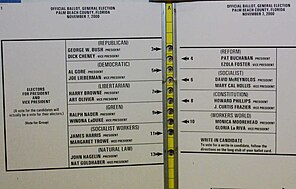| Part of the Politics series |
| Politics |
|---|
|
|
Election science is a branch of social choice theory dealing with the conduct and administration of elections. It is distinct from the study of public opinion and election forecasting (which fall under political science and psephology). Election science can be thought of as the practical application of social choice theory to the conduct of elections (making it more closely affiliated with welfare economics).

The study of election science can be traced back to early scientific studies of electoral systems and particularly the development of the field of social choice theory, including the Marquis de Condorcet's analysis of electoral systems in the 18th century. The field came into being following the 2000 United States presidential election, [1] where several administrative [2] and technical failures [3] may have affected the outcome of the election. Examples of subjects where election science methods are applied include gerrymandering, electoral fraud, suffrage, and voter registration.
There is an academic conference [4] dedicated to the study of election science and the Southern Political Science Association has a sub-conference for the study of election science. [5] In addition, multiple universities now offer a bachelor of science in political science for a data science track. [6] [7]
See also
References
- ^ Brams, Stephan J.; Herschbach, Dudley R. (2001). "The Science of Elections". Science. 292 (5521): 1449. doi: 10.1126/science.292.5521.1449. PMID 11379606. S2CID 28262658.
- ^ Stuart, Guy (2004). "Databases, Felons, and Voting: Bias and Partisanship of the Florida Felons List in the 2000 Elections". Political Science Quarterly. 119 (3): 453–475. doi: 10.2307/20202391. JSTOR 20202391. Retrieved 2023-02-10.
- ^ Wand, Jonathan N. (December 1, 2001). "The Butterfly Did It: The Aberrant Vote for Buchanan in Palm Beach County, Florida". American Political Science Review. 95 (4): 793–810. doi: 10.1017/S000305540040002X. JSTOR 3117714. S2CID 12182778. Archived from the original on November 24, 2016. Retrieved 2023-02-10.
- ^ "Election Science, Reform, and Administration Conference". esra-conference.org. Retrieved 2023-02-10.
- ^ "2023 Election Science Conference-within-a-Conference". Joseph A. Coll. Retrieved 2023-02-10.
- ^ "BS in Data Sciences in Political Science". American University. Retrieved 2023-02-10.
- ^ "Data Science Track | Political Science". politicalscience.stanford.edu. Retrieved 2023-02-10.
External links
- "Deepening the Field of Election Science". MIT Election & Data Science Lab. Retrieved 2023-02-10.
| Part of the Politics series |
| Politics |
|---|
|
|
Election science is a branch of social choice theory dealing with the conduct and administration of elections. It is distinct from the study of public opinion and election forecasting (which fall under political science and psephology). Election science can be thought of as the practical application of social choice theory to the conduct of elections (making it more closely affiliated with welfare economics).

The study of election science can be traced back to early scientific studies of electoral systems and particularly the development of the field of social choice theory, including the Marquis de Condorcet's analysis of electoral systems in the 18th century. The field came into being following the 2000 United States presidential election, [1] where several administrative [2] and technical failures [3] may have affected the outcome of the election. Examples of subjects where election science methods are applied include gerrymandering, electoral fraud, suffrage, and voter registration.
There is an academic conference [4] dedicated to the study of election science and the Southern Political Science Association has a sub-conference for the study of election science. [5] In addition, multiple universities now offer a bachelor of science in political science for a data science track. [6] [7]
See also
References
- ^ Brams, Stephan J.; Herschbach, Dudley R. (2001). "The Science of Elections". Science. 292 (5521): 1449. doi: 10.1126/science.292.5521.1449. PMID 11379606. S2CID 28262658.
- ^ Stuart, Guy (2004). "Databases, Felons, and Voting: Bias and Partisanship of the Florida Felons List in the 2000 Elections". Political Science Quarterly. 119 (3): 453–475. doi: 10.2307/20202391. JSTOR 20202391. Retrieved 2023-02-10.
- ^ Wand, Jonathan N. (December 1, 2001). "The Butterfly Did It: The Aberrant Vote for Buchanan in Palm Beach County, Florida". American Political Science Review. 95 (4): 793–810. doi: 10.1017/S000305540040002X. JSTOR 3117714. S2CID 12182778. Archived from the original on November 24, 2016. Retrieved 2023-02-10.
- ^ "Election Science, Reform, and Administration Conference". esra-conference.org. Retrieved 2023-02-10.
- ^ "2023 Election Science Conference-within-a-Conference". Joseph A. Coll. Retrieved 2023-02-10.
- ^ "BS in Data Sciences in Political Science". American University. Retrieved 2023-02-10.
- ^ "Data Science Track | Political Science". politicalscience.stanford.edu. Retrieved 2023-02-10.
External links
- "Deepening the Field of Election Science". MIT Election & Data Science Lab. Retrieved 2023-02-10.